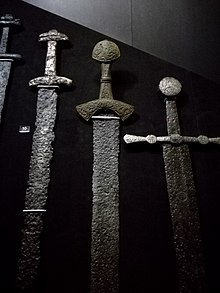


The Suontaka sword (Finnish: Suontaan miekka) was found in what was previously interpreted as a high-status woman's grave at Suontaka Vesitorninmäki, Tyrväntö, Finland in 1968.[1] Based on a study published in 2021, the sword was likely hidden in the grave some time after the burial.[2] The grave dates from the late Nordic Iron Age, c. 1040–1174 AD, and it also included another hiltless sword with silver-inlays that was placed directly on the buried corpse. Ancient DNA analysis found that the individual likely had Klinefelter syndrome, indicated through the presence of XXY chromosomes.[2] The individual had been buried in a female dress with three brooches.[citation needed]
The bronze-hilted sword was made with grip and hilt entirely in hollow cast bronze.[3] The sword blade contains texts +NMIN+ and +NIOIN+, which can be abbreviations of In nomine Domini (Latin for "In the name of the Lord")[4] or variations of the text "in the name of god".[3][verification needed] The sword is considered to be a unique work of art for its time.[citation needed]
Suontaka village is in Häme, Finland. This area of Häme is known for its numerous sword-findings and archaeological sites.[5] The time during which the sword was in use was a prosperous yet violent time in the Häme region. The original sword is in display in the National Museum of Finland.[citation needed] Interpretations have suggested the burial is evidence of gender fluidity in the past.[6]
This article relating to swords is a stub. You can help Wikipedia by expanding it. |
This article about Finland history is a stub. You can help Wikipedia by expanding it. |